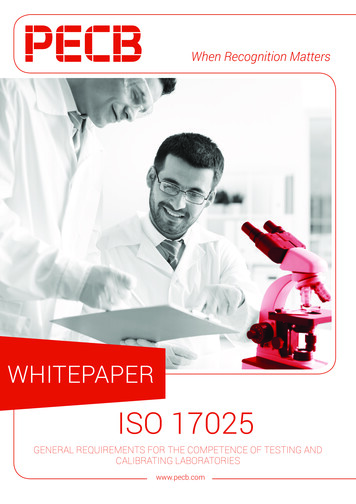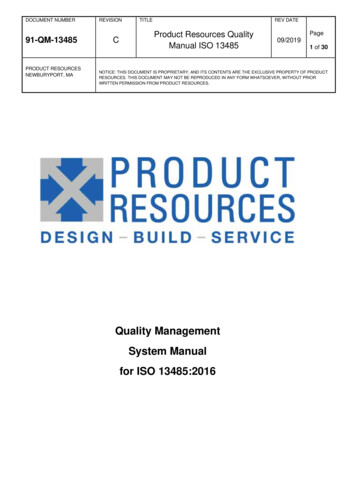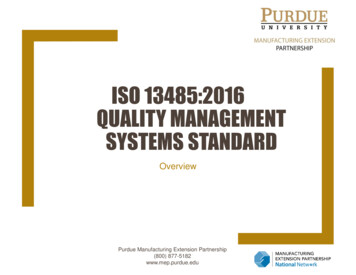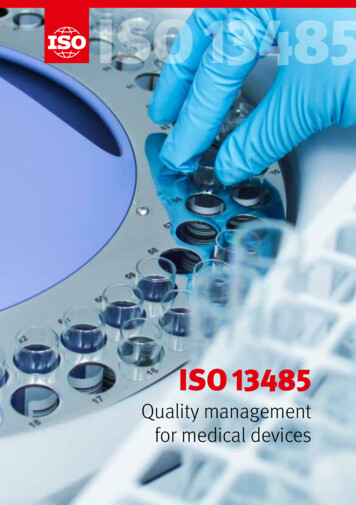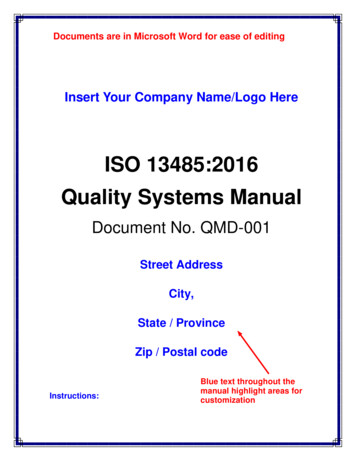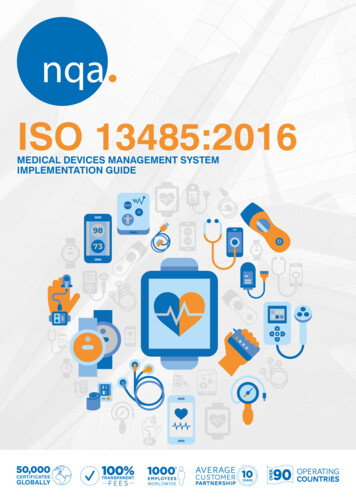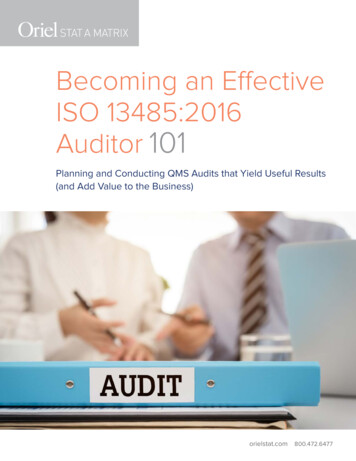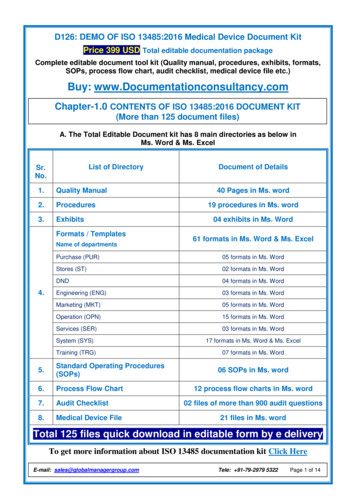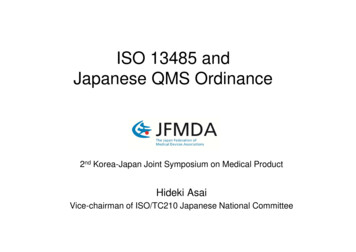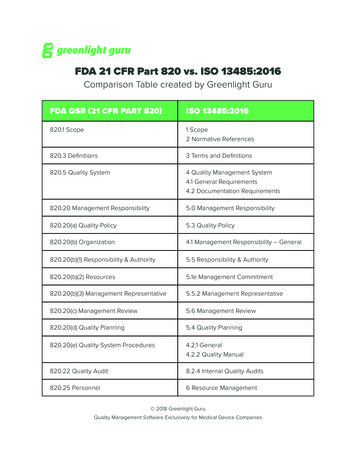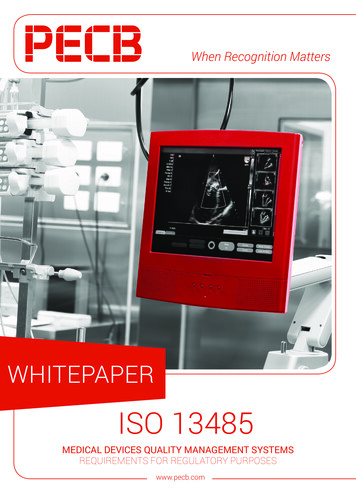
Transcription
When Recognition MattersWHITEPAPERISO 13485MEDICAL DEVICES QUALITY MANAGEMENT SYSTEMSREQUIREMENTS FOR REGULATORY PURPOSESwww.pecb.com
CONTENT3Introduction4An Overview of ISO 13485:20035Key Clauses of ISO 13485:20036Link of ISO 13485 with other Standards6ISO 13485 opposed to ISO 90017What are the Benefits of Quality Management?8Why is PECB a Worthy Choice?9Steps for Obtaining a PECB CertificationPRINCIPAL AUTHORSEric LACHAPELLE, PECBBesnik HUNDOZI, PECB2ISO 13485 // MEDICAL DEVICES QUALITY MANAGEMENT SYSTEMS
INTRODUCTIONAn audited and certified medical device quality management system issued by a third-party is often required,or strongly preferred, by regulatory authorities in most major markets such as EU, USA, Canada, Japan andTaiwan, for manufacturers that want to sell medical devices in these respective countries.This International Standard is suitable for all sizes and types of organizations that are involved in the lifecycleof a medical device and are seeking for improvements on how they are operated and managed. It can beused by an organization for the design and development, production, installation and servicing of medicaldevices, and the design, development, and provision of related services.Since the ISO 13485 International Standard is based on a process approach to quality management, apartfrom establishing a quality management system that complies with the standard, it is also essential tocomply with product and service technical standards and regulations.Despite the fact that ISO 13485:2003 is based on the ISO 9001:2000 quality management standard, it is stilla stand-alone standard.According to the latest ISO Survey of Management System Standard Certifications, up to the end ofDecember 2013, at least 25, 666 ISO 13485:2003 certificates, a growth of 15 % ( 3, 349), had been issuedin 95 countries and economies, two less than in the previous year.The table below summarizes the statistics of the ISO 13485 certifications around the world.StandardNumber of certificatesin 2013Number ofcertificates in 2012EvolutionEvolution in %ISO 1348525, 66622, 3173, 34915 %Source: iso.orgThus, ISO 13485 shows a 15 % increment from the past year.The top three countries for the total number of certificates issued were the USA, Germany and Italy, whilethe top three for growth in the number of certificates in 2013 were the USA, China and Greece.ISO 13485 MEDICAL DEVICES QUALITY MANAGEMENT SYSTEMS3
AN OVERVIEW OF ISO 13485:2003ISO 13485 specifies requirements where an organization needs to demonstrate its ability to provide medicaldevices and related services that consistently meet customer requirements and regulatory requirementsapplicable to medical devices and related services.All requirements of ISO 13485 are specific to organizations providing medical devices, regardless of thetype or size of the organization.Quality standardization evolves with ISO 13485 by adding: Greater emphasis on setting the objectives, monitoring performance and metrics; Clearer expectations on management; and More careful planning for and preparing the resources needed for ensuring quality.What is a Quality Management System?Quality management system is defined as a set of interrelated or interacting elements to establish policyand objectives for an organization and to achieve those objectives with regard to quality.ISO 13485 APPLIES TO ALL TYPES AND SIZES OF ORGANIZATIONS THAT WISH TO:1. Establish, document, implement, maintain a QMS and maintain its effectiveness;2. Assure conformity with the organization’s stated quality policy;3. Demonstrate conformity to others;4. Seek certification/registration of its QMS by an accredited third party certification body; or5. Make a self-determination and self-declaration of conformity with this International Standard.4ISO 13485 // MEDICAL DEVICES QUALITY MANAGEMENT SYSTEMS
KEY CLAUSES OF ISO 13485:2003ISO 13485 IS ORGANIZED INTO THE FOLLOWING MAIN CLAUSES:Clause 4: Quality management systemClause 5: Management responsibilityClause 6: Resource managementClause 7: Product realizationClause 8: Measurement, analysis and improvementEach of these key activities is overviewed below.CLAUSE 4: QUALITY MANAGEMENT SYSTEMAn organization shall establish and document their quality management system for medical devices, basedon the requirements of ISO 13485.CLAUSE 5: MANAGEMENT RESPONSIBILITY Top management shall support quality by: Promoting the importance of quality; Developing a quality management system; and Implementing and maintaining the quality management system// There shall be focused attention on customers by expecting people and the organization to identify andmeet these requirements.// A quality policy shall be defined and managed by top management through: Ensuring that the quality policy serves the organization’s purpose and meets requirements; and Communicating the policy throughout the organization, and reviewing it to ensure its continuedsuitability. // Top management shall perform quality planning by: Formulating quality objectives to ensure that they are set for all functional areas and organizationallevels; and Planning, developing, implementing, improving and modifying the quality management system.// Top management shall control the quality management system by: Defining responsibilities and authorities; Appointing a management representative; and Supporting internal communications.// Top management shall carry out management reviews by: Reviewing the quality management system; Examining management review inputs; and Generating management review outputs.CLAUSE 6: RESOURCE MANAGEMENTThe actions that should be taken to assure effective resource management in an organization are to: Provide quality resources; Provide quality personnel; Provide quality infrastructure; and Provide quality environment.ISO 13485 MEDICAL DEVICES QUALITY MANAGEMENT SYSTEMS5
CLAUSE 7: PRODUCT REALIZATIONThe processes involved in the organization’s product realization are: Control realization planning; Control customer processes; Control product design and development; Control the purchasing function; Manage production and service provision; and Control monitoring devices.CLAUSE 8: MEASUREMENT, ANALYSIS AND IMPROVEMENTThe processes that ensure the effectiveness of the measurement, analysis and improvement requirements are: Performing improvement processes; Monitoring and measuring quality; Controlling nonconforming products; Analyzing quality information; and Taking required improvement actions.LINK OF ISO 13485 WITH OTHERSTANDARDSISO 13485 is linked with several other medical device standards: ISO/TR 14969:2004, Medical Devices – Quality Management Systems – Guidance on the applicationof ISO 13485.This standard serves as guidance for the application of the requirements for quality management systemscontained in ISO 13485. It provides guidance on how to understand the requirements of ISO 13485 andexplains different methods that are available for meeting the requirements of ISO 13485. ISO 14971:2007, Medical Devices – Application of risk management to medical devices.This standard specifies the requirements for application of a risk management system for medical devices.It specifies a process for a manufacturer to identify the hazard associated with medical devices, including invitro diagnostic (IVD) medical devices, to estimate and evaluate the associated risks, to control these risks,and to monitor the effectiveness of the controls.ISO 13485 OPPOSED TO ISO 9001As mentioned above, ISO 13485 is based on the structure of ISO 9001, even though it is a stand-alonestandard.Despite that both standards are organized in the same way, ISO 13485 excludes ISO 9001 requirementsrelated to continual improvement and customer satisfaction. The reasons for this exclusion are that mostmedical device regulations require organizations to maintain their quality management systems insteadof improving them; and committee members thought that customer satisfaction was too subjective toindicate in ISO 13485.6ISO 13485 // MEDICAL DEVICES QUALITY MANAGEMENT SYSTEMS
WHAT ARE THE BUSINESS BENEFITS OFQUALITY MANAGEMENT?As with all the major undertakings within an organization, it is essential to gain the backing and sponsorshipof the executive management. By far, the best way to achieve this is to illustrate the positive gains of havingan effective quality management process in place, rather than highlight the negative aspects of the contrary.Today an effective quality management system is not about being forced into taking action to addressexternal pressures, but its importance relies on recognizing the positive value of quality management whengood practice is embedded throughout your organization.Better understanding of theorganizationRegulatory complianceCost reductionConfidence of clientContract complianceCompetitive advantageIncreased efficiencyLegal complianceRespect of the interested partiesThe adoption of an effective quality management process within an organization will have many benefitsin a number of areas: Extended market access through meeting regulatory requirements; Increased revenue through meeting customer requirements; Increased efficiency; Reduced cost of sales; Improved performance; Staff motivation; Better definition of roles and responsibilities; etc.ISO 13485 MEDICAL DEVICES QUALITY MANAGEMENT SYSTEMS7
WHY IS PECB A WORTHY CHOICE?Implementation of QMS with IMS2 methodologyConsidering the well documented benefits of implementing a Quality Management System based on ISO13485, makes the proposal easier to decide on.Most companies now realize that it is not sufficient to implement a generic, “one size fits all” quality plan.For an effective response, with respect to maintaining the quality management system, such a plan mustbe customized to fit to a company. A more difficult task is the compilation of an implementation plan thatbalances the requirements of the standard, the business needs and the certification deadline.There is no single blueprint for implementing ISO 13485 that will work for every company, but there aresome common steps that will allow you to balance the frequent conflicting requirements and prepare youfor a successful certification audit.PECB has developed a methodology (please see example below) for implementing a management system;the “Integrated Implementation Methodology for Management Systems and Standards (IMS2)”, and it isbased on applicable best practices. This methodology is based on the guidelines of ISO standards and alsomeets the requirements of ISO 13485.4. PLAN3. DO2. CHECK1. ACT1.1 Initiating the QMS2.1 OrganizationalStructure3.1 Monitoring,Measurement,Analysis andEvaluation4.1 Treatment ofnon-conformities1.2 Understanding theOrganization1.3 Analyze theExisting System2.2 DocumentManagement2.3 Design of Controlsand Procedures1.4 Leadership andProject Approval2.4 Communication1.5 Scope2.5 Awareness andTraining1.6 Quality Policy2.6 ProductRealization3.2 Internal Audit4.2 Improvement3.3 ManagementReview2.7 OperationsManagementIMS2 is based on the PDCA cycle divided into four phases: Plan, Do, Check and Act. Each phase has between2 and 8 steps for a total of 18 steps. In turn, these steps are divided into 101 activities and tasks. This‘Practical Guide’ considers the key phases in your implementation project from start to finish and suggeststhe appropriate ‘best practice’ for each one, while directing your to further helpful resources as you embarkon your ISO 13485 journey.8ISO 13485 // MEDICAL DEVICES QUALITY MANAGEMENT SYSTEMS
ProjectsCheckActThe sequence of steps can be changed (inversion, merge). For example, the implementation of themanagement procedure for documented information can be done before the understanding of theorganization. Many processes are iterative because of the need for progressive development throughoutthe implementation project; for example, communication and training.By following a structured and effective methodology, an organization can be sure it covers all minimumrequirements for the implementation of a management system. Whatever methodology used, theorganization must adapt it to its particular context (requirements, size of the organization, scope, objectives,etc.) and not apply it like a cookbook.STEPS FOR OBTAINING A PECBCERTIFICATIONFor organizations:For individuals:1. Implement the management system1. Participate in the training course2. Perform internal audit and reviews2. Register for the certification exam3. Select preferred certification body3. Sit for the certification exam4. Perform a pre-assessment audit (optional)4. Apply for the certification scheme uponsuccessful completion5. Perform the stage 1 audit5. Obtain certification6. Perform the stage 2 audit (on-site)7. Perform a follow-up audit (optional)8. Register the certification9. Assure continual improvement by conductingsurveillance auditsFor further details relating the types of trainings and certifications that PECB offers, please visit our website:www.pecb.comISO 13485 MEDICAL DEVICES QUALITY MANAGEMENT SYSTEMS9
1-844-426-7322customer@pecb.comCustomer Servicewww.pecb.com
Despite the fact that ISO 13485:2003 is based on the ISO 9001:2000 quality management standard, it is still a stand-alone standard. According to the latest ISO Survey of Management System Standard Certifications,up to the end of December 2013, at least 25, 666 ISO 13485:2003

